CSR activities at universities: The case of Hanoi University of Industry
ABSTRACT
Applying qualitative research, this paper reports findings of a study
exploring if Corporate Social Responsibilities (CSR) is conducted at Universities,
and the case of Hanoi University of Industry (HaUI). The findings based on
secondary data reveal that HaUI are conducting a variety of CSR activities
covering four areas namely (i) human rights, (ii) labour practice, (iii) environment
and (iv)anti-corruption. This study consists of an exploratory approach comprised
of a critical review of the scholarly and refereed literature, with an emphasis on
identifying the social responsibilities of an educational institution today, basing
on its printed and electronic documents. The study opens a number of topics for
further research such as the CSR perceptions of staff and managers or
effectiveness of single/groups of CSR activities and their effects on organisational
performance.

Trang 1
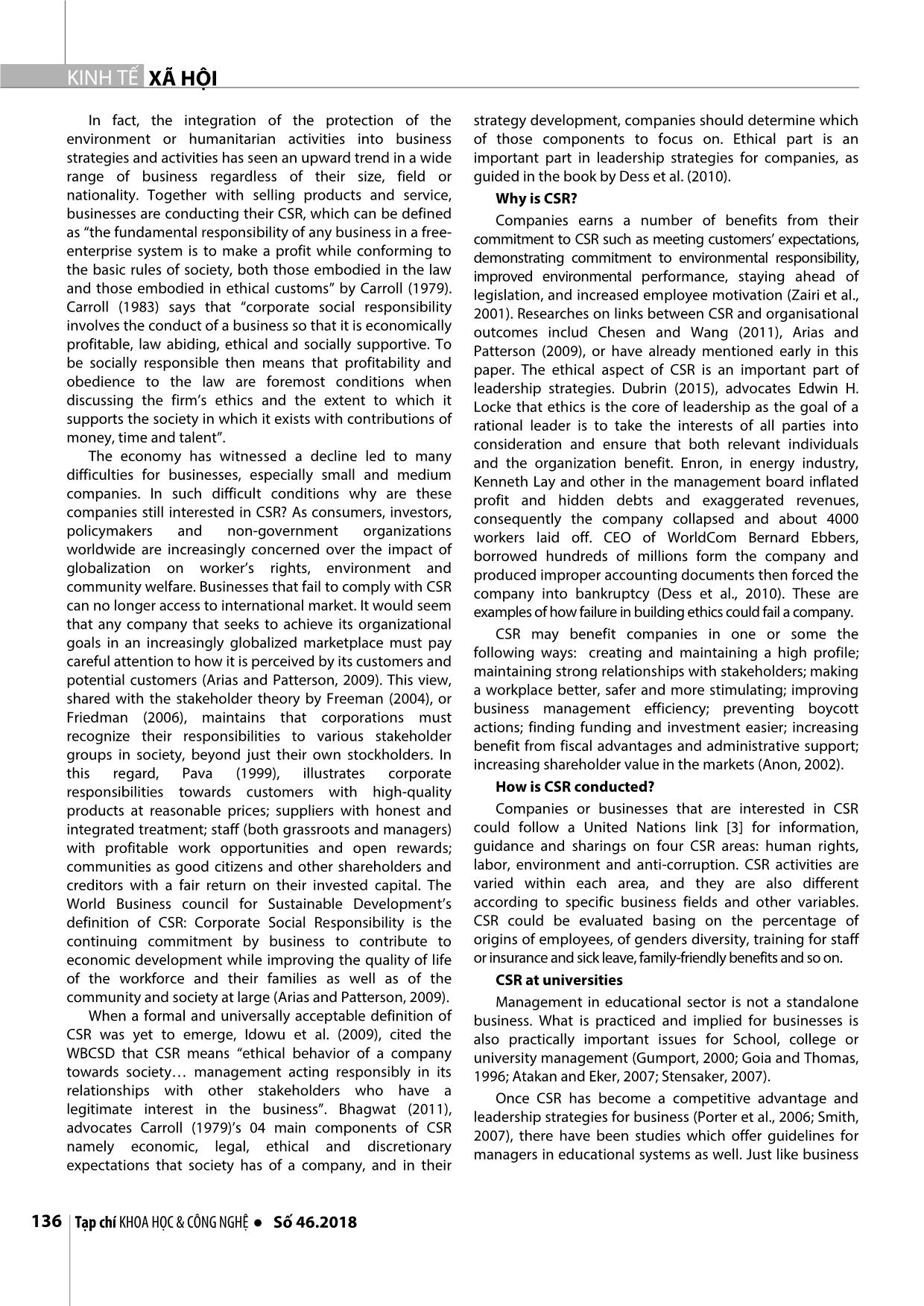
Trang 2
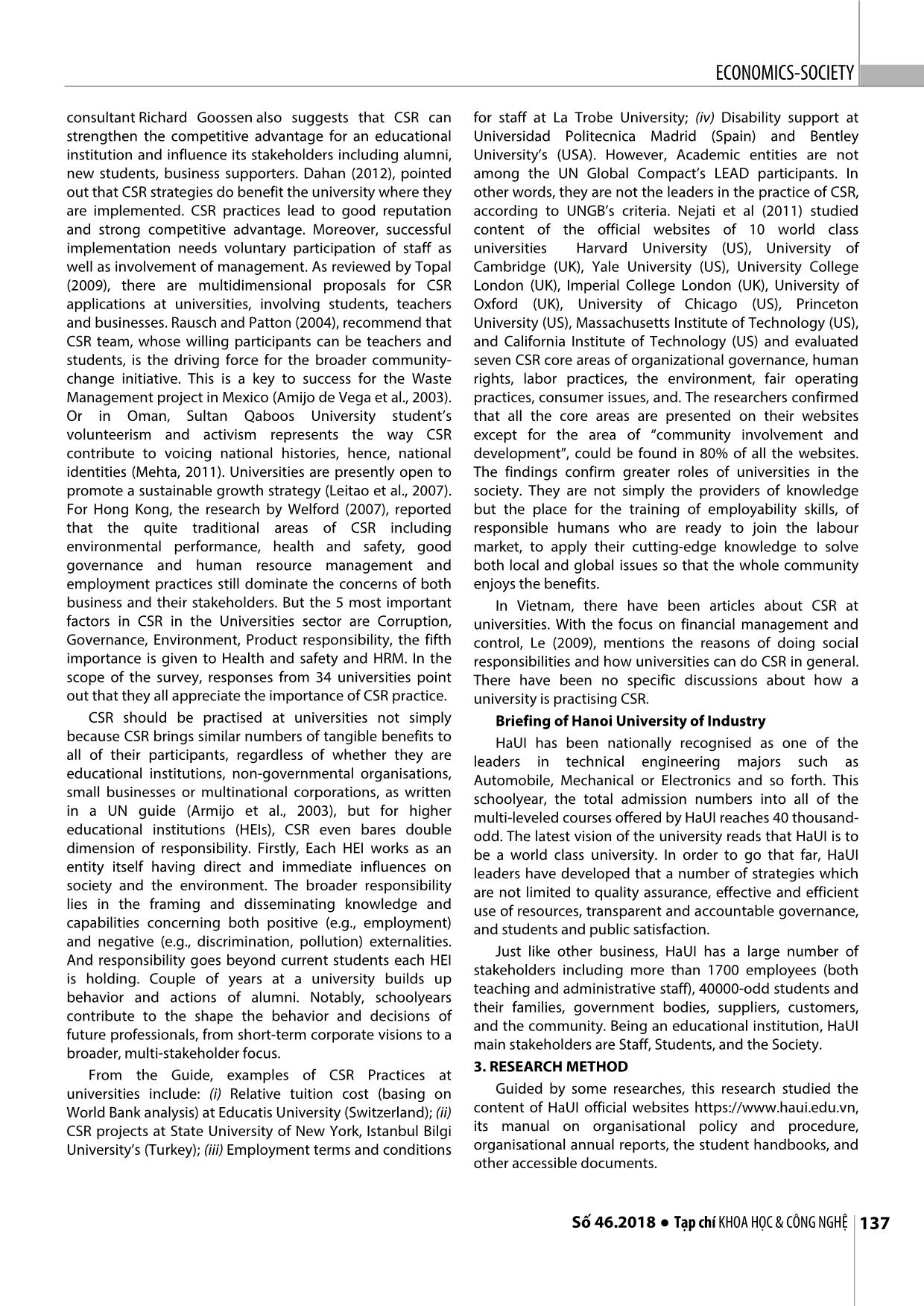
Trang 3

Trang 4
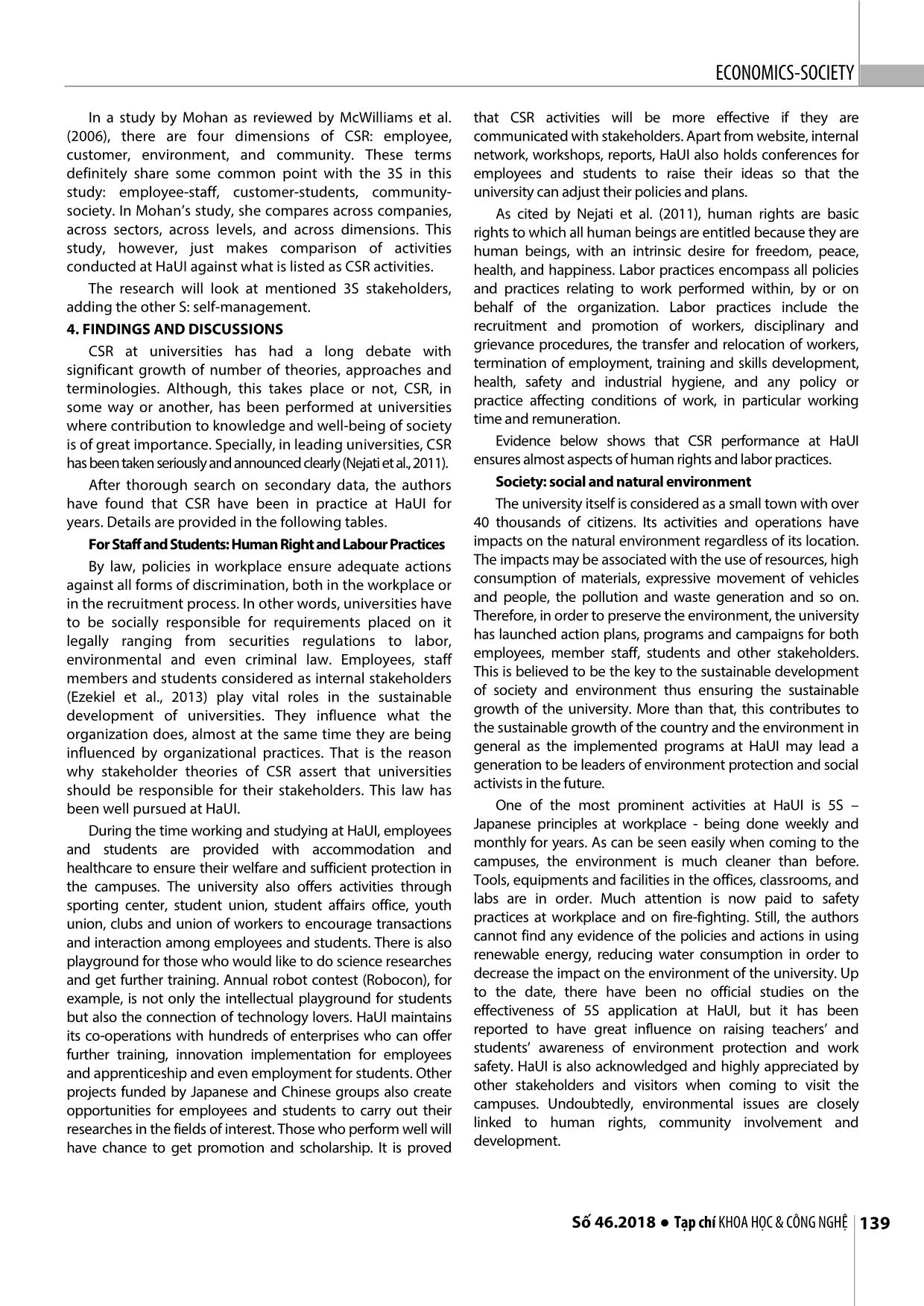
Trang 5
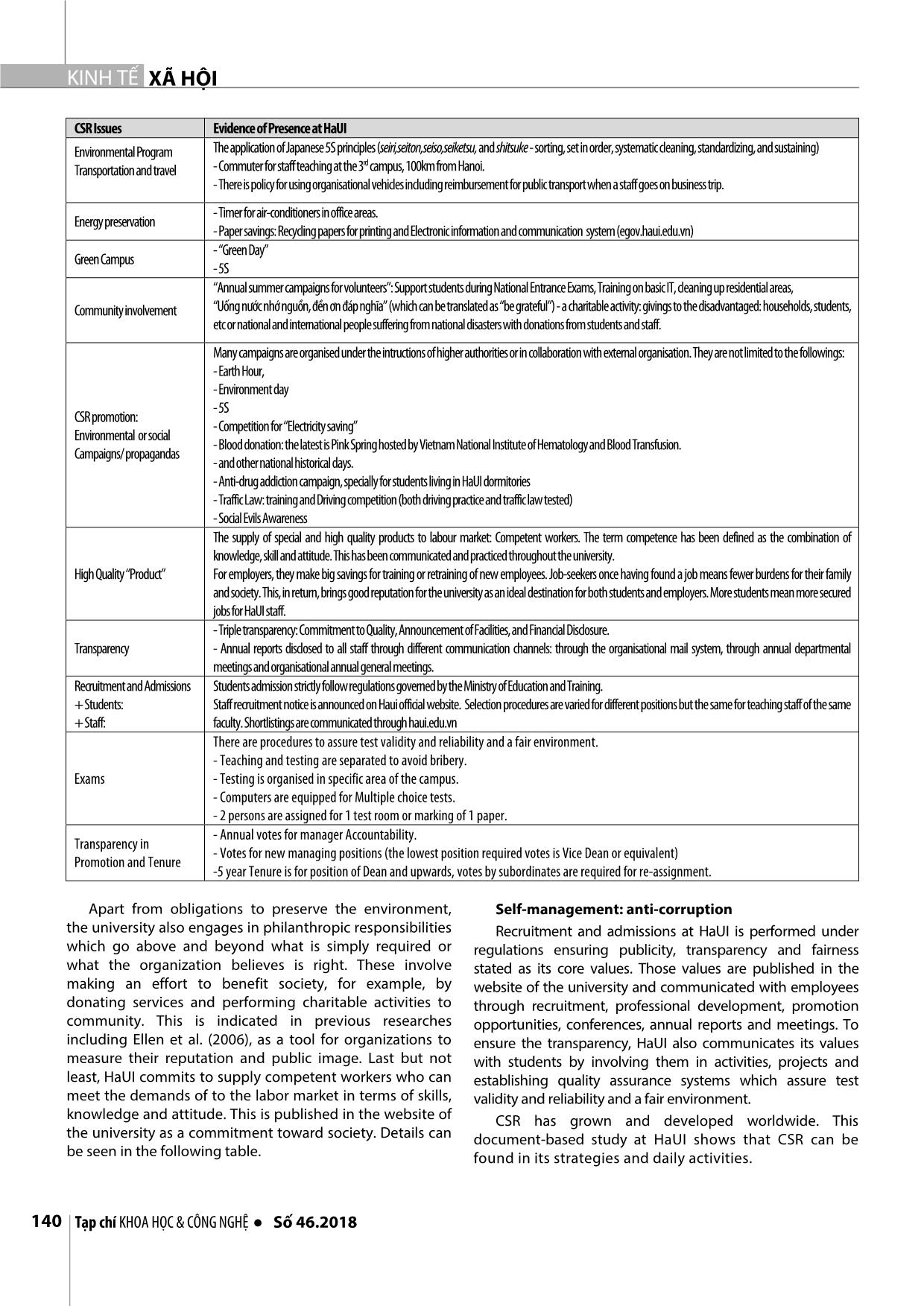
Trang 6
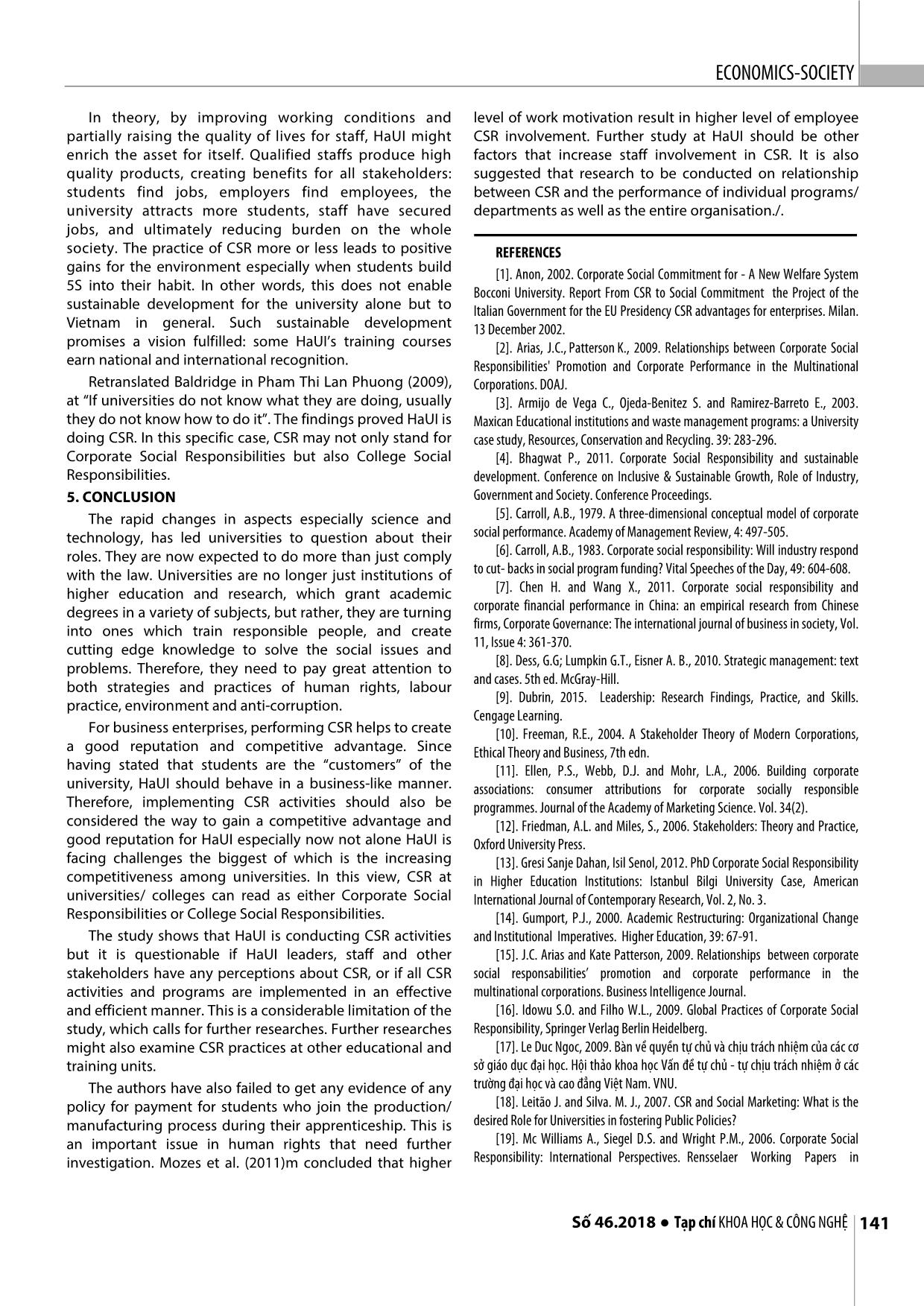
Trang 7
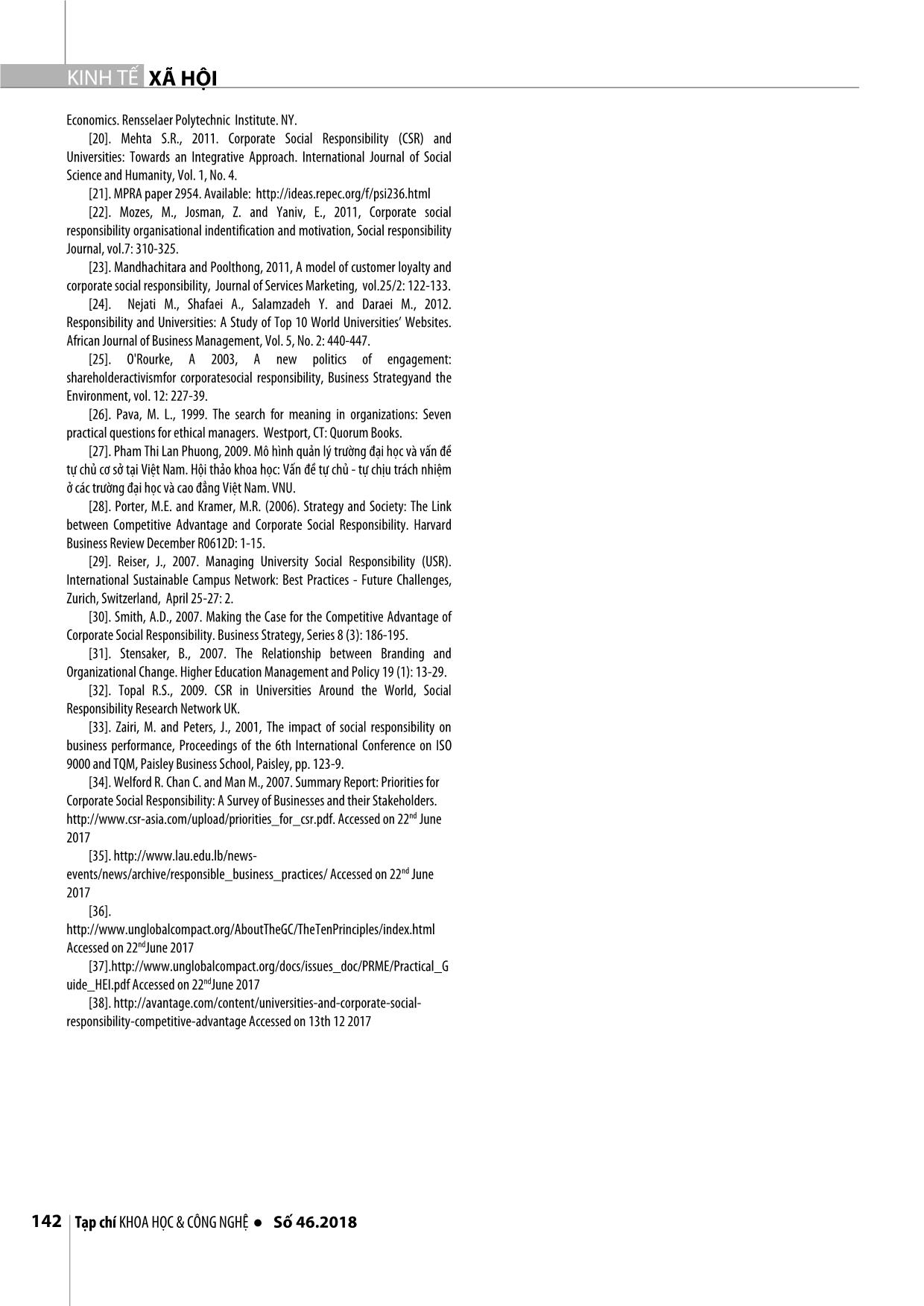
Trang 8
Tóm tắt nội dung tài liệu: CSR activities at universities: The case of Hanoi University of Industry
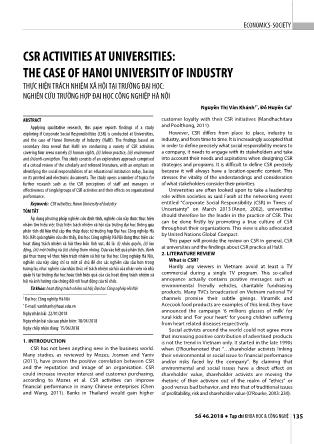
preserve the environment, the university also engages in philanthropic responsibilities which go above and beyond what is simply required or what the organization believes is right. These involve making an effort to benefit society, for example, by donating services and performing charitable activities to community. This is indicated in previous researches including Ellen et al. (2006), as a tool for organizations to measure their reputation and public image. Last but not least, HaUI commits to supply competent workers who can meet the demands of to the labor market in terms of skills, knowledge and attitude. This is published in the website of the university as a commitment toward society. Details can be seen in the following table. Self-management: anti-corruption Recruitment and admissions at HaUI is performed under regulations ensuring publicity, transparency and fairness stated as its core values. Those values are published in the website of the university and communicated with employees through recruitment, professional development, promotion opportunities, conferences, annual reports and meetings. To ensure the transparency, HaUI also communicates its values with students by involving them in activities, projects and establishing quality assurance systems which assure test validity and reliability and a fair environment. CSR has grown and developed worldwide. This document-based study at HaUI shows that CSR can be found in its strategies and daily activities. CSR Issues Evidence of Presence at HaUI Environmental Program Transportation and travel The application of Japanese 5S principles (seiri,seiton,seiso,seiketsu, and shitsuke - sorting, set in order, systematic cleaning, standardizing, and sustaining) - Commuter for staff teaching at the 3rd campus, 100km from Hanoi. - There is policy for using organisational vehicles including reimbursement for public transport when a staff goes on business trip. Energy preservation - Timer for air-conditioners in office areas. - Paper savings: Recycling papers for printing and Electronic information and communication system (egov.haui.edu.vn) Green Campus - “Green Day” - 5S Community involvement “Annual summer campaigns for volunteers”: Support students during National Entrance Exams, Training on basic IT, cleaning up residential areas, “Uống nước nhớ nguồn, đền ơn đáp nghĩa” (which can be translated as “be grateful”) - a charitable activity: givings to the disadvantaged: households, students, etc or national and international people suffering from national disasters with donations from students and staff. CSR promotion: Environmental or social Campaigns/ propagandas Many campaigns are organised under the intructions of higher authorities or in collaboration with external organisation. They are not limited to the followings: - Earth Hour, - Environment day - 5S - Competition for “Electricity saving” - Blood donation: the latest is Pink Spring hosted by Vietnam National Institute of Hematology and Blood Transfusion. - and other national historical days. - Anti-drug addiction campaign, specially for students living in HaUI dormitories - Traffic Law: training and Driving competition (both driving practice and traffic law tested) - Social Evils Awareness High Quality “Product” The supply of special and high quality products to labour market: Competent workers. The term competence has been defined as the combination of knowledge, skill and attitude. This has been communicated and practiced throughout the university. For employers, they make big savings for training or retraining of new employees. Job-seekers once having found a job means fewer burdens for their family and society. This, in return, brings good reputation for the university as an ideal destination for both students and employers. More students mean more secured jobs for HaUI staff. Transparency - Triple transparency: Commitment to Quality, Announcement of Facilities, and Financial Disclosure. - Annual reports disclosed to all staff through different communication channels: through the organisational mail system, through annual departmental meetings and organisational annual general meetings. Recruitment and Admissions + Students: + Staff: Students admission strictly follow regulations governed by the Ministry of Education and Training. Staff recruitment notice is announced on Haui official website. Selection procedures are varied for different positions but the same for teaching staff of the same faculty. Shortlistings are communicated through haui.edu.vn Exams There are procedures to assure test validity and reliability and a fair environment. - Teaching and testing are separated to avoid bribery. - Testing is organised in specific area of the campus. - Computers are equipped for Multiple choice tests. - 2 persons are assigned for 1 test room or marking of 1 paper. Transparency in Promotion and Tenure - Annual votes for manager Accountability. - Votes for new managing positions (the lowest position required votes is Vice Dean or equivalent) -5 year Tenure is for position of Dean and upwards, votes by subordinates are required for re-assignment. ECONOMICS-SOCIETY Số 46.2018 ● Tạp chí KHOA HỌC & CÔNG NGHỆ 141 In theory, by improving working conditions and partially raising the quality of lives for staff, HaUI might enrich the asset for itself. Qualified staffs produce high quality products, creating benefits for all stakeholders: students find jobs, employers find employees, the university attracts more students, staff have secured jobs, and ultimately reducing burden on the whole society. The practice of CSR more or less leads to positive gains for the environment especially when students build 5S into their habit. In other words, this does not enable sustainable development for the university alone but to Vietnam in general. Such sustainable development promises a vision fulfilled: some HaUI’s training courses earn national and international recognition. Retranslated Baldridge in Pham Thi Lan Phuong (2009), at “If universities do not know what they are doing, usually they do not know how to do it”. The findings proved HaUI is doing CSR. In this specific case, CSR may not only stand for Corporate Social Responsibilities but also College Social Responsibilities. 5. CONCLUSION The rapid changes in aspects especially science and technology, has led universities to question about their roles. They are now expected to do more than just comply with the law. Universities are no longer just institutions of higher education and research, which grant academic degrees in a variety of subjects, but rather, they are turning into ones which train responsible people, and create cutting edge knowledge to solve the social issues and problems. Therefore, they need to pay great attention to both strategies and practices of human rights, labour practice, environment and anti-corruption. For business enterprises, performing CSR helps to create a good reputation and competitive advantage. Since having stated that students are the “customers” of the university, HaUI should behave in a business-like manner. Therefore, implementing CSR activities should also be considered the way to gain a competitive advantage and good reputation for HaUI especially now not alone HaUI is facing challenges the biggest of which is the increasing competitiveness among universities. In this view, CSR at universities/ colleges can read as either Corporate Social Responsibilities or College Social Responsibilities. The study shows that HaUI is conducting CSR activities but it is questionable if HaUI leaders, staff and other stakeholders have any perceptions about CSR, or if all CSR activities and programs are implemented in an effective and efficient manner. This is a considerable limitation of the study, which calls for further researches. Further researches might also examine CSR practices at other educational and training units. The authors have also failed to get any evidence of any policy for payment for students who join the production/ manufacturing process during their apprenticeship. This is an important issue in human rights that need further investigation. Mozes et al. (2011)m concluded that higher level of work motivation result in higher level of employee CSR involvement. Further study at HaUI should be other factors that increase staff involvement in CSR. It is also suggested that research to be conducted on relationship between CSR and the performance of individual programs/ departments as well as the entire organisation./. REFERENCES [1]. Anon, 2002. Corporate Social Commitment for - A New Welfare System Bocconi University. Report From CSR to Social Commitment the Project of the Italian Government for the EU Presidency CSR advantages for enterprises. Milan. 13 December 2002. [2]. Arias, J.C., Patterson K., 2009. Relationships between Corporate Social Responsibilities' Promotion and Corporate Performance in the Multinational Corporations. DOAJ. [3]. Armijo de Vega C., Ojeda-Benitez S. and Ramirez-Barreto E., 2003. Maxican Educational institutions and waste management programs: a University case study, Resources, Conservation and Recycling. 39: 283-296. [4]. Bhagwat P., 2011. Corporate Social Responsibility and sustainable development. Conference on Inclusive & Sustainable Growth, Role of Industry, Government and Society. Conference Proceedings. [5]. Carroll, A.B., 1979. A three-dimensional conceptual model of corporate social performance. Academy of Management Review, 4: 497-505. [6]. Carroll, A.B., 1983. Corporate social responsibility: Will industry respond to cut- backs in social program funding? Vital Speeches of the Day, 49: 604-608. [7]. Chen H. and Wang X., 2011. Corporate social responsibility and corporate financial performance in China: an empirical research from Chinese firms, Corporate Governance: The international journal of business in society, Vol. 11, Issue 4: 361-370. [8]. Dess, G.G; Lumpkin G.T., Eisner A. B., 2010. Strategic management: text and cases. 5th ed. McGray-Hill. [9]. Dubrin, 2015. Leadership: Research Findings, Practice, and Skills. Cengage Learning. [10]. Freeman, R.E., 2004. A Stakeholder Theory of Modern Corporations, Ethical Theory and Business, 7th edn. [11]. Ellen, P.S., Webb, D.J. and Mohr, L.A., 2006. Building corporate associations: consumer attributions for corporate socially responsible programmes. Journal of the Academy of Marketing Science. Vol. 34(2). [12]. Friedman, A.L. and Miles, S., 2006. Stakeholders: Theory and Practice, Oxford University Press. [13]. Gresi Sanje Dahan, Isil Senol, 2012. PhD Corporate Social Responsibility in Higher Education Institutions: Istanbul Bilgi University Case, American International Journal of Contemporary Research, Vol. 2, No. 3. [14]. Gumport, P.J., 2000. Academic Restructuring: Organizational Change and Institutional Imperatives. Higher Education, 39: 67-91. [15]. J.C. Arias and Kate Patterson, 2009. Relationships between corporate social responsabilities’ promotion and corporate performance in the multinational corporations. Business Intelligence Journal. [16]. Idowu S.O. and Filho W.L., 2009. Global Practices of Corporate Social Responsibility, Springer Verlag Berlin Heidelberg. [17]. Le Duc Ngoc, 2009. Bàn về quyền tự chủ và chịu trách nhiệm của các cơ sở giáo dục đại học. Hội thảo khoa học Vấn đề tự chủ - tự chịu trách nhiệm ở các trường đại học và cao đẳng Việt Nam. VNU. [18]. Leitão J. and Silva. M. J., 2007. CSR and Social Marketing: What is the desired Role for Universities in fostering Public Policies? [19]. Mc Williams A., Siegel D.S. and Wright P.M., 2006. Corporate Social Responsibility: International Perspectives. Rensselaer Working Papers in XÃ HỘI Tạp chí KHOA HỌC & CÔNG NGHỆ ● Số 46.2018 142 KINH TẾ Economics. Rensselaer Polytechnic Institute. NY. [20]. Mehta S.R., 2011. Corporate Social Responsibility (CSR) and Universities: Towards an Integrative Approach. International Journal of Social Science and Humanity, Vol. 1, No. 4. [21]. MPRA paper 2954. Available: [22]. Mozes, M., Josman, Z. and Yaniv, E., 2011, Corporate social responsibility organisational indentification and motivation, Social responsibility Journal, vol.7: 310-325. [23]. Mandhachitara and Poolthong, 2011, A model of customer loyalty and corporate social responsibility, Journal of Services Marketing, vol.25/2: 122-133. [24]. Nejati M., Shafaei A., Salamzadeh Y. and Daraei M., 2012. Responsibility and Universities: A Study of Top 10 World Universities’ Websites. African Journal of Business Management, Vol. 5, No. 2: 440-447. [25]. O'Rourke, A 2003, A new politics of engagement: shareholderactivismfor corporatesocial responsibility, Business Strategyand the Environment, vol. 12: 227-39. [26]. Pava, M. L., 1999. The search for meaning in organizations: Seven practical questions for ethical managers. Westport, CT: Quorum Books. [27]. Pham Thi Lan Phuong, 2009. Mô hình quản lý trường đại học và vấn đề tự chủ cơ sở tại Việt Nam. Hội thảo khoa học: Vấn đề tự chủ - tự chịu trách nhiệm ở các trường đại học và cao đẳng Việt Nam. VNU. [28]. Porter, M.E. and Kramer, M.R. (2006). Strategy and Society: The Link between Competitive Advantage and Corporate Social Responsibility. Harvard Business Review December R0612D: 1-15. [29]. Reiser, J., 2007. Managing University Social Responsibility (USR). International Sustainable Campus Network: Best Practices - Future Challenges, Zurich, Switzerland, April 25-27: 2. [30]. Smith, A.D., 2007. Making the Case for the Competitive Advantage of Corporate Social Responsibility. Business Strategy, Series 8 (3): 186-195. [31]. Stensaker, B., 2007. The Relationship between Branding and Organizational Change. Higher Education Management and Policy 19 (1): 13-29. [32]. Topal R.S., 2009. CSR in Universities Around the World, Social Responsibility Research Network UK. [33]. Zairi, M. and Peters, J., 2001, The impact of social responsibility on business performance, Proceedings of the 6th International Conference on ISO 9000 and TQM, Paisley Business School, Paisley, pp. 123-9. [34]. Welford R. Chan C. and Man M., 2007. Summary Report: Priorities for Corporate Social Responsibility: A Survey of Businesses and their Stakeholders. Accessed on 22nd June 2017 [35]. events/news/archive/responsible_business_practices/ Accessed on 22nd June 2017 [36]. Accessed on 22ndJune 2017 [37]. uide_HEI.pdf Accessed on 22ndJune 2017 [38]. responsibility-competitive-advantage Accessed on 13th 12 2017
File đính kèm:
 csr_activities_at_universities_the_case_of_hanoi_university.pdf
csr_activities_at_universities_the_case_of_hanoi_university.pdf

